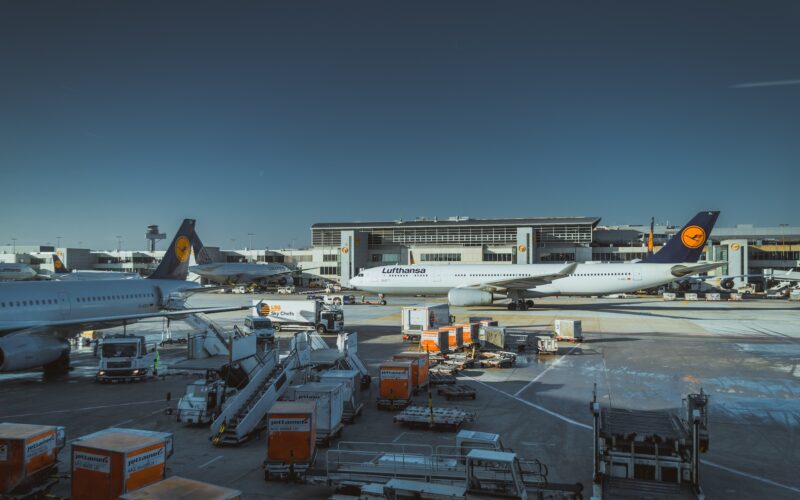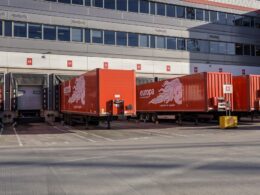Undoubtedly, air freight, along with every other shipping method, is changing considerably. To understand this better, let’s examine how automation and technology are changing air freight shipping.
The role of automation in air freight shipping
Automated cargo handling systems
Automated cargo handling systems have revolutionized the air freight shipping industry by streamlining operations and reducing human errors. These systems utilize advanced technologies to efficiently and accurately handle cargo, mitigating some of the challenges in supply chain management. With automated processes for loading and unloading cargo, we reduce the risk of mishandling or damage. These systems rely on robotic arms and conveyor belts to transport goods swiftly and safely, ensuring timely deliveries. Automation increases efficiency and productivity by eliminating the need for manual labour in repetitive tasks. Moreover, these systems are equipped with sensors and scanners that can accurately track and trace packages, enhancing visibility and minimizing the risk of lost or misplaced shipments. Overall, automated cargo handling systems are crucial in optimizing air freight operations, enhancing customer satisfaction, and improving the reliability of global supply chains.
Robotic processes in air freight operations
Robotic processes are revolutionizing how we handle and manage goods and are a significant example of how automation and technology are changing air freight shipping. Specifically, we deploy robotics technology for various tasks, including sorting and labeling packages, cargo inspection, and warehouse management. Automated sorting systems use advanced algorithms to categorize and arrange packages, improving efficiency and reducing errors. Furthermore, autonomous drones are also being used for cargo inspection, enabling quick and accurate assessments of shipments. These drones can capture high-resolution images and videos, providing valuable data for security and compliance purposes. Additionally, robotics is crucial in warehouse management, where automated systems are utilized for inventory tracking, storage optimization, and order fulfillment. By integrating robotics into air freight operations, companies can achieve higher speed, precision, and cost-effectiveness levels.
Advantages and challenges of automation
Automation brings many advantages to air freight shipping but also presents certain challenges. On the positive side, automation enhances efficiency by reducing the need for manual labor, resulting in faster and more accurate cargo handling. Furthermore, it minimizes human errors and improves productivity, ultimately saving business costs. Automation also enables real-time tracking and visibility of shipments, providing valuable data for decision-making and improving customer satisfaction. However, there are some challenges as well. One major obstacle is the initial investment to implement automation systems and technologies. Integrating these systems into existing infrastructure and workflows can be complex and time-consuming. Additionally, there may be resistance from the workforce due to concerns about job displacement. Cybersecurity also becomes critical as automation relies heavily on interconnected systems and data exchange.
The technology transforming air freight operations
The Internet of Things (IoT) in cargo tracking
With IoT devices, you can monitor shipments in real time, providing valuable visibility throughout the supply chain. These devices have sensors that collect and transmit data on various parameters, such as location, temperature, humidity, and vibrations. This data is then analyzed to ensure cargo is handled appropriately and detect potential issues or deviations from expected conditions. IoT in cargo tracking enhances security by enabling immediate alerts in case of unauthorized access or tampering. It also facilitates proactive decision-making, allowing timely interventions and adjustments to ensure on-time deliveries. The seamless integration of IoT devices with other technologies, such as cloud computing and data analytics, further enhances the accuracy and usefulness of cargo tracking data.
Artificial Intelligence (AI) and Machine Learning (ML)
Artificial Intelligence (AI) and Machine Learning (ML) have transformed the air freight shipping industry by enabling advanced data analysis and decision-making capabilities. AI algorithms can analyse massive amounts of data, identify patterns, and make accurate predictions, which helps optimize route planning, capacity management, and demand forecasting. Machine Learning algorithms continuously learn from new data, improving their performance. Air freight shipping means better efficiency, reduced costs, and improved customer service. The Homegrown Moving and Storage experts point out that AI and ML are not limited to air freight alone. They find utility in various industries, including the moving industry. For example, ML algorithms can analyse historical data to estimate the time and resources required for a move, while AI-powered chatbots can provide personalized customer support.
Blockchain technology for transparency and security
Blockchain technology provides unparalleled transparency and security. With blockchain, every transaction and event in the supply chain is recorded on a decentralized and immutable ledger, ensuring an auditable and tamper-proof record. This level of transparency helps in managing risks and maintaining compliance with regulations. By eliminating intermediaries, blockchain reduces the risk of fraud and unauthorized alterations to shipment data. This technology also introduces smart contracts, which automate and enforce contractual agreements, streamlining processes and reducing disputes.
Moreover, the distributed nature of blockchain enhances data integrity as information is replicated across multiple nodes, making it highly resistant to hacking and data manipulation. Logistics companies can leverage blockchain to establish trust among stakeholders, enhance supply chain visibility, and mitigate risks associated with fraudulent activities. Embracing blockchain technology can significantly improve logistics operations’ overall efficiency, security, and compliance.
The implications of automation and technology
The implications of automation and technology changes are far-reaching and set to shape the future of logistics. By embracing automation, companies can achieve increased efficiency and cost-effectiveness by streamlining manual processes and minimizing errors. Advanced technologies such as robotics, the Internet of Things (IoT), and artificial intelligence (AI) enhance safety and security measures, ensuring smooth operations and reducing risks. Integrating automation and technology also brings about workforce implications, with a shift towards more specialized roles that require technological expertise. Moreover, there is a growing emphasis on sustainability and environmental impact, with automation enabling optimized route planning and fuel efficiency. The future of logistics will see further advancements in automation with the integration of 5G, edge computing, and autonomous aircraft. By leveraging the potential of automation and technology, air freight shipping makes way for a more efficient, secure, and environmentally conscious future.
Examples of how automation and technology are changing air freight shipping
Several case studies exemplify the successful implementation of automation and technology. One noteworthy example is Amazon Prime Air’s drone delivery system, which utilizes autonomous drones for fast and efficient package delivery. These drones can navigate through various obstacles and deliver packages to customers’ doorsteps within a short timeframe. Another case study involves the integration of autonomous vehicles in cargo transportation. Companies like Einride have developed electric and self-driving trucks that can transport goods autonomously. That reduces the need for human drivers and increases efficiency.
Additionally, AI and robotics are transforming air cargo handling centers. For instance, Vanderlande’s automated solutions use robotic arms and conveyor systems to sort and transport packages, minimizing errors.
Wrestling with the influence of automation and technology
Now that you understand how automation and technology are changing air freight shipping, one thing should be apparent. Namely, keeping up with the latest tech will only become more important! So, do not hesitate to do just that.













